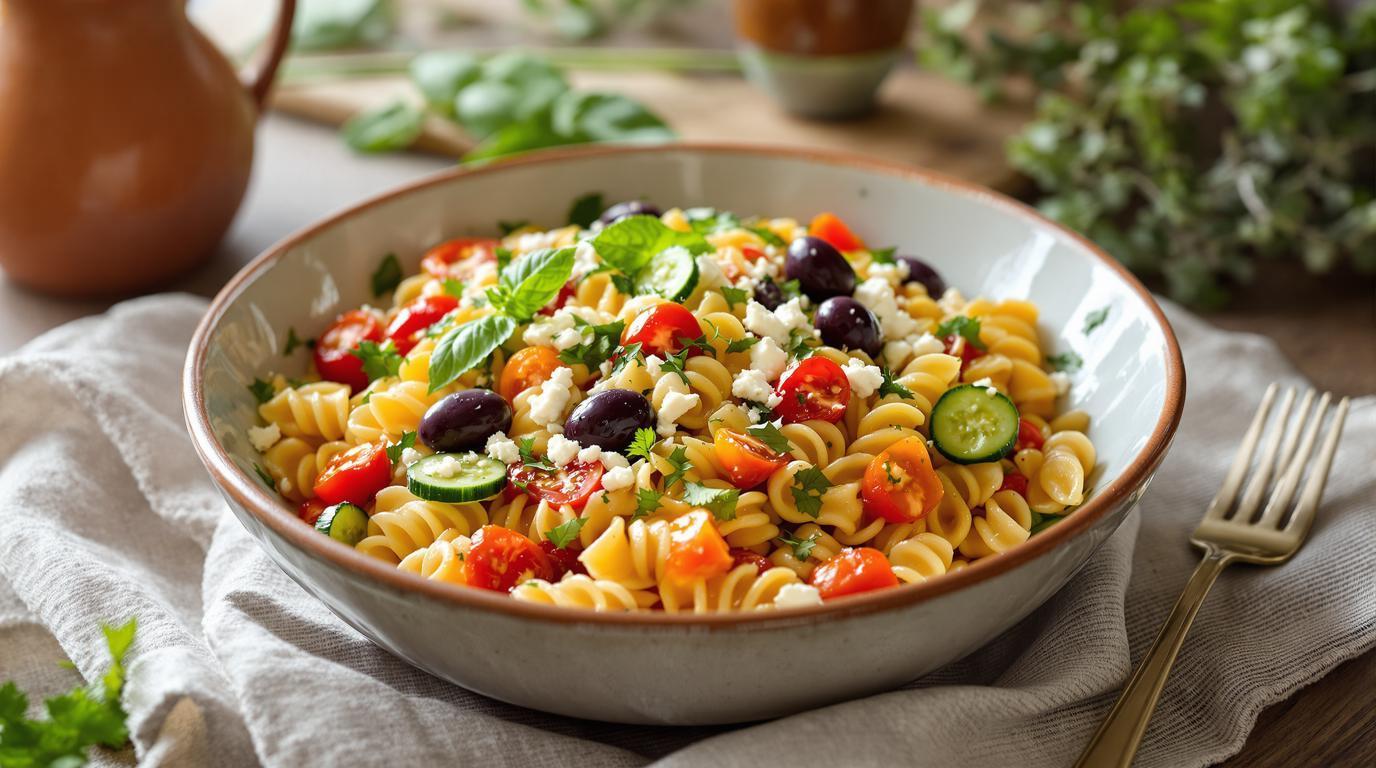The first time I tasted a true Mediterranean grandmother-style pasta salad wasn’t in a fancy restaurant, but at a small coastal farmhouse in Southern Italy. What struck me was how something so simple—pasta tossed with garden vegetables, olives, and herbs—could deliver such profound flavor. The secret? Everything was treated with intention, from the perfectly al dente pasta to the careful balance of briny olives against sweet tomatoes. This pasta salad isn’t just food; it’s Mediterranean summer captured in a bowl—vibrant, refreshing, and somehow both rustic and elegant at once.
The Story
Mediterranean pasta salad emerged from the practical wisdom of coastal grandmothers who needed satisfying, make-ahead dishes that wouldn’t wilt in the summer heat. What makes this version special is its adherence to tradition while offering the perfect canvas for seasonal adaptation. Unlike American pasta salads drowning in mayonnaise, this Mediterranean classic relies on quality olive oil and the natural juices of ripe vegetables to create a light yet satisfying meal that actually tastes better after it sits for a few hours.
Ingredients Spotlight
For the salad (serves 4):
• 12 oz (340g) short pasta (fusilli, farfalle, or penne)
• 1 pint (300g) cherry tomatoes, halved
• 1 medium cucumber, seeded and diced (about 1 cup/150g)
• 1 red bell pepper, diced (about 1 cup/150g)
• ½ medium red onion, thinly sliced (about ½ cup/75g)
• ⅔ cup (100g) Kalamata olives, pitted and halved
• 6 oz (170g) feta cheese, cubed or crumbled
• ¼ cup (15g) fresh basil leaves, torn
• 2 Tbsp (8g) fresh oregano leaves (or 1 tsp dried)
For the dressing:
• ⅓ cup (80ml) extra virgin olive oil
• 3 Tbsp (45ml) red wine vinegar
• 1 garlic clove, finely minced
• 1 tsp Dijon mustard
• 1 tsp honey
• ½ tsp sea salt
• ¼ tsp freshly ground black pepper
Step-by-Step Guide
1. Cook the pasta in heavily salted water (it should taste like the sea) for exactly 1 minute less than package instructions. We want it truly al dente since it will continue absorbing dressing.
2. Shock and drain the pasta by immediately running under cold water for 30 seconds, then shake off excess water and transfer to a large bowl. Toss with 1 Tbsp olive oil to prevent sticking.
3. Make the dressing by whisking all dressing ingredients in a small bowl until emulsified. The mustard is key here—it helps everything stay blended.
4. Combine all vegetables with the pasta, reserving a handful of feta and herbs for garnish.
5. Dress the salad by pouring two-thirds of the dressing over the pasta mixture and tossing gently. Let it rest for 10-15 minutes, then taste and add more dressing as needed.
6. Finish and serve by topping with reserved feta, fresh herbs, and a drizzle of your best olive oil right before serving.
Expert Techniques
The key to elevating this salad lies in three professional techniques. First, cutting vegetables to similar sizes ensures balanced bites and even distribution. I aim for pieces about the size of the pasta you’re using. Second, layering flavors by adding ingredients in stages—some herbs in the mix, some reserved for garnish—creates depth. Finally, the resting period is non-negotiable; allowing the pasta to absorb the dressing is what transforms this from good to magnificent.
Chef’s Note: Temperature matters enormously with this dish. Never serve it cold straight from the refrigerator—the flavors become muted and the olive oil congeals. Instead, remove it 30 minutes before serving to allow it to come to cool room temperature, when the Mediterranean flavors truly shine.
Presentation & Pairing Ideas
Serve this pasta salad in a wide, shallow bowl rather than piled high—this creates a beautiful canvas where every colorful ingredient is visible. For an elegant touch, place a few whole basil leaves and a light dusting of lemon zest on top.
This salad pairs beautifully with a crisp Vermentino or Assyrtiko wine. For a complete meal, serve alongside grilled fish or lemon-herb chicken. In cooler months, try a warm variation by lightly sautéing the bell peppers and adding roasted eggplant—proof that Mediterranean wisdom works year-round.
Don’t be afraid to make this recipe your own. The Mediterranean grandmother’s true legacy wasn’t rigid adherence to recipes, but understanding how ingredients speak to each other. Listen to your palate—if you love artichokes or sun-dried tomatoes, incorporate them. The beauty of this dish is that it welcomes adaptation while maintaining its soul. Your perfect version is waiting to be discovered in your own kitchen, using your hands and guided by your taste. That’s not just cooking—that’s creating edible memories. 🌿🍝✨
